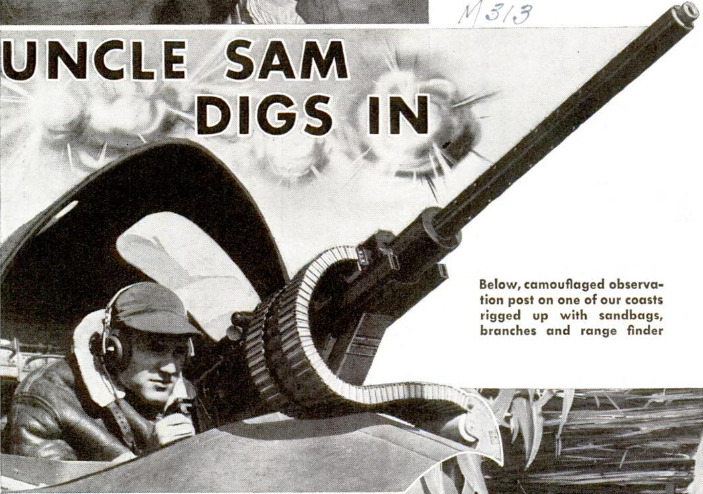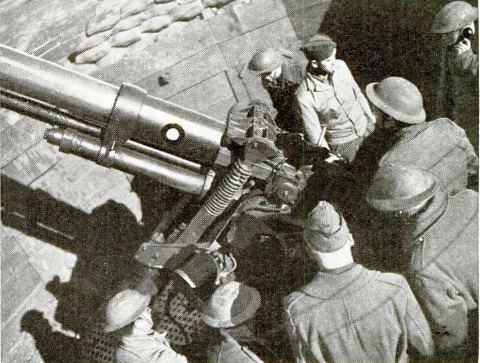lT LOOKED like a sub, the little streak of white water with a dark shadow below it, and the gunner phoned its position to the cockpit. The heavily loaded plane swung around to have a closer look while the bombardier settled himself for the sighting run. Then everybody relaxed. It was another whale, after all. The big bomber was on outer patrol, a good fraction of the distance to Honolulu, and it was making a sweep that might last all day. The plane was one unit of a vast aerial organization that is guarding our east and west coasts against surprise attack. Close inshore, other planes of the bomber command were ready to pounce on any enemy submarines that they might sight in the coastal traffic lanes. Blimps slowly patrolled their over-water beats. Atadvance airdromes back of the beaches, pursuit planes were standing by, fueled and armed for the alarm that might come tonight and that might never come. The big bomber had left its base long before daybreak that morning. It had joined a procession of mammoth shapes that had lumbered and rumbled out to the runway, then waited its turn to roar across the field and lift its load into the air. The sun was just clearing the horizon when the bombers crossed a coastal mountain range, following a flight path that was secret for today and that would be changed for tomorrow. Approaching the coast, the planes scattered out to fulfill their assignments. The men on this particular bomber are anxious for the time - it might come today - when they can help to pay back the Japs for Pearl Harbor. Their great, almost clumsy-looking four-engined plane is heavy with bombs that are as tall as a man and powerful enough to crush a submarine or pierce an armored deck. Crawl down from the cockpit, squeeze yourself past the mechanism of the bombs, wriggle past the retracted nose wheel, and you find yourself in the bombardier’s plastic nose cage. He is on the alert. At his left is the panel by which he retracts the bomb bay doors, selects the bombs and launches them. In front of him is the bombsight. Below him is a gun. In fact, the bomber is studded with guns, all heavy enough to blast apart armored planes that could hardly be hurt by the aerial guns of 20 years ago. At open ports in the fuselage the side gunners stand by their gear. They are huskies who can man-handle the protruding gun barrels up or down or forward in the terrific wind. Overhead, the gunner in the power turret needs a different sort of skill, for he points his turret with delicate touches on a set of keys. In the tail of the plane, the rear gunner has pulled back the sides of his cage and is sitting in the open so that he can maneuver his gun easily if he gets a chance. By the time the bomber turns back for shore, other bombers are leaving hidden bases to take up the patrol. Sometimes the gunners need to replenish their ammunition cans after they have landed. They may have been testing their aim against clouds, or they may have had other targets. Sometimes the bomb bay is empty. Such a fact, backed up by the wide grins of the flight crew, remains a military secret for a while. The bomber patrols and what they are accomplishing are only a chapter in the story of our continental defense system. The navy’s inshore patrol, the aircraft detection system, and our coast defenses are some of the other parts of the organization. Each of our coasts is an armed camp today. Many enemy aliens have been moved and others will go out of the defense areas. The army has moved in. Ordinary citizens go about their business as usual, unhampered by the precautions that are being taken to protect them. Posters warn. them to avoid talking about what they see though the fact is that most people, busy with everyday life, see only a fraction of what is going on. Many patriotic citizens are serving as airplane spotters, air raid wardens, and are performing other duties in their spare time. Air raid sirens are installed on top of traffic signal standards, placards on buildings point the way to the nearest shelters, and piles of sand are spotted here and there in case of need for quelling incendiaries. Barrage balloons sway in the sky in some areas. Flocks of interceptor planes that look like dragonflies and that are so fast that the noise of their engines seems to drone from the sky miles behind them swoop and maneuver overhead. Railroad engines wear hoods over their headlights to prevent their beams from escaping upward. Air line terminal buildings, along with defense factories and other vital buildings, are blacked out for the duration of the war. You enter such a building through a “light lock.” Going through an entrance door, you find yourself in a black closet with another door in front of you. Close the entrance door behind you, then open the inner door. That way, no light leaks out. Occasionally, a radio silence is ordered and all radio stations go off the air. Less frequently, a blackout occurs. These precautions are sometimes taken when unidentified aircraft or surface vessels are reported offshore or when enemy submarines are known to be on the prowl. Shore lights or radio broadcasts might give them the directions they need to do harm, providing perfect beacons to lead the enemy to its goal. In some areas you are apt to notice anti-aircraft guns in vacant lots or fields. Searchlights may be mounted on tall buildings or hilltops. On some nights searchlight practice is held and you stand in the street and watch an airplane trying to dodge away from the converging beams of the searchlights. Fortified strong points have been established along beaches and headlands but there have been no restrictions for ordinary swimming and beach parties. At some more exposed positions along the coasts the troops have gone underground, digging themselves living quarters below the surface, walled and roofed with empty aircraft engine crates,and protected with sand bags. They have strung electric lines to their dugouts for illumination and they provide their own hot water for shower baths by turning a blow torch on a cold water line. All in all, the United States today resembles a well armed and bristling porcupine, ready to repulse all invaders. And having completed his home defenses, Uncle Sam is now carrying the fight to the enemy.




